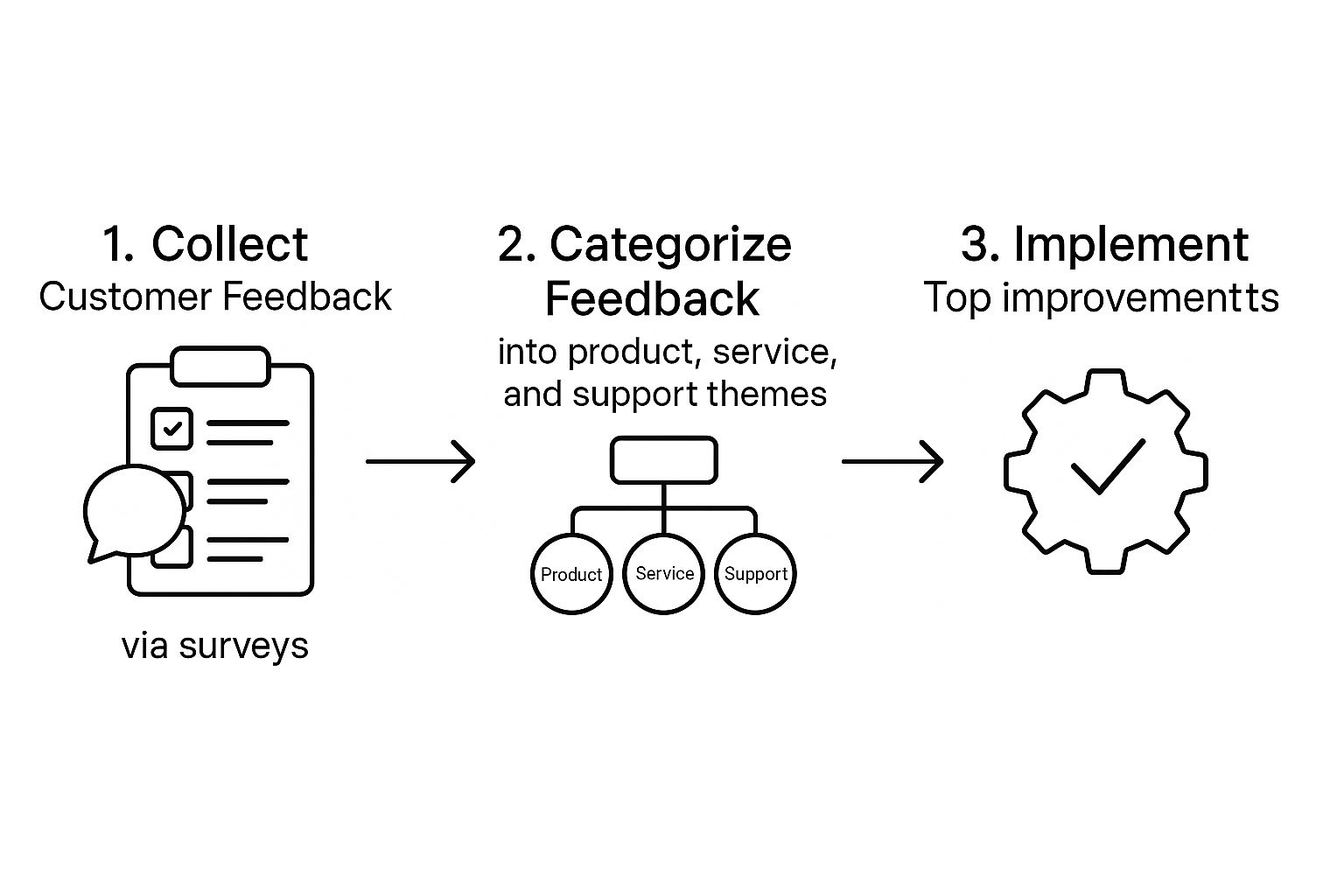To really boost customer satisfaction, businesses have to make a fundamental shift. It's about moving from a reactive "fix-it" mentality to a proactive, forward-thinking approach. I've found that the winning formula rests on three pillars: proactive service, deep personalization, and seamless problem-solving. This isn't just theory; it's a framework that directly tackles what modern customers actually want and turns everyday interactions into genuine opportunities to build loyalty.
Why Customer Satisfaction Is Declining

If you feel like it's getting harder to keep customers happy, you're not wrong. It’s a real and measurable trend. Despite huge investments in customer experience (CX), satisfaction levels are actually dropping across most industries. This isn't just a blip on the radar—it's a systemic problem fueled by sky-high expectations and new economic anxieties.
The data backs this up. For the second year in a row, a staggering 25% of brands in the U.S. saw their customer experience scores fall. Only a tiny 7% actually improved. These scores look at everything from how effective and easy the experience was to the emotional connection a customer feels, so this decline is hitting businesses on all fronts. If you want to dig deeper, Forrester.com offers some great insights on why customer loyalty is taking such a hit.
The Problem with Old Strategies
Here’s the heart of the issue: the old, reactive service model is officially broken. Today's customers are used to instant, easy, and personalized everything. Simply waiting for a customer to complain and then swooping in to fix it is a surefire way to lose them. It creates friction and makes people feel like they’re just another ticket in a queue.
On top of that, people are more careful with their money than ever. With economic uncertainty looming, they're scrutinizing every single purchase. They expect businesses to know them and anticipate their needs, not just react when something goes wrong.
The real game-changer isn't just meeting expectations anymore; it's about getting ahead of them before the customer even thinks to ask. This proactive mindset is what separates the brands that thrive from those that are just trying to keep their heads above water.
Three Pillars For a Modern Approach
To turn this trend around and start delighting customers again, you need to build your strategy on three pillars that speak directly to these new realities.
- Proactive Service: This is all about spotting and solving potential problems before they affect the customer. A classic example is sending a notification about a shipping delay before they even have a chance to check their tracking number.
- Deep Personalization: We have to move way beyond just using a customer’s first name in an email. True personalization means using data to tailor every touchpoint—from product recommendations to support interactions—so each customer feels genuinely seen and valued.
- Seamless Problem-Solving: When issues inevitably pop up, the fix has to be incredibly fast and easy. Customers shouldn't have to jump through hoops. Every single interaction, especially when something goes wrong, needs to feel effortless.
These three pillars—Proactive Service, Deep Personalization, and Seamless Problem-Solving—form the foundation of a modern customer satisfaction strategy. They shift the focus from merely reacting to problems to actively creating positive, loyalty-building experiences.
Below is a table that breaks down how these concepts work in practice and the impact they can have on your business.
Three Pillars of Modern Customer Satisfaction
| Pillar | Core Principle | Business Impact |
|---|---|---|
| Proactive Service | Anticipate and solve issues before the customer is aware of them. | Reduces inbound support tickets, builds trust, and prevents customer frustration. |
| Deep Personalization | Use customer data to tailor the entire experience to individual needs. | Increases engagement, drives higher conversion rates, and fosters a strong emotional connection. |
| Seamless Problem-Solving | Make it fast and effortless for customers to get help when they need it. | Boosts customer retention, improves CSAT scores, and generates positive word-of-mouth. |
By building your customer experience around these principles, you're not just fixing the flaws of the old model. You're creating a system that's designed to meet the high expectations of today's consumers, turning potential detractors into your most vocal advocates.
Map Your Customer Journey to Find Friction
If you really want to make your customers happier, you first have to see your business through their eyes. It's simple: you can't fix a problem you don't even know exists. That's why mapping the customer journey is so critical. The idea is to trace every single interaction someone has with your business, from their first Google search all the way to a final support call.
This isn't some theoretical whiteboard exercise. It's about getting into the trenches and gathering real data at each touchpoint to find "friction points." These are the moments of frustration, confusion, or just plain effort that kill satisfaction. By figuring out exactly where your experience is breaking down, you can stop guessing and start making targeted fixes that actually move the needle.
Identifying Key Touchpoints
Let's say you run an e-commerce brand. That customer journey might look something like this:
- Someone lands on your website and starts poking around, discovering products.
- They add a few items to their cart and begin the checkout process.
- They get the order confirmation and shipping update emails.
- The package finally arrives, and they have that unboxing moment.
- Later, they need to contact support with a question or a return request.
Every single one of these steps is a fork in the road—an opportunity to either delight or disappoint. A clunky checkout page or a painfully slow reply to a support ticket? Those are classic friction points that can undo all the goodwill you've built up.
The goal of journey mapping is simple: find out where you’re making things difficult for your customers. Every point of friction is a chance to improve and, in turn, boost satisfaction and loyalty.
This visual lays out a straightforward but effective way to turn that feedback into real change.

The big takeaway here is that feedback is pretty much useless unless you have a system to sort through it and tackle the biggest problems first.
Now, think about a service-based business, like a towing company. The touchpoints are completely different but just as crucial. The journey often starts with a frantic, late-night call. The friction could be a busy signal, an endless hold time, or an unhelpful dispatcher. This is where tools like an AI phone assistant can be a game-changer, completely eliminating that initial friction. Every call gets answered instantly and professionally, setting a positive tone for the whole experience from the very first second.
Get Ahead of Problems with Proactive, Personal Communication

Once you've pinpointed where your customers are getting tripped up, the real magic happens when you get ahead of those problems entirely. This is about flipping the script from being reactive to being proactive. Instead of waiting for a customer to ask, “Where’s my order?” you've already sent them a shipping update.
This simple shift builds an incredible amount of trust. Think about it: if you know a particular page on your site, like the checkout, tends to confuse people, why wait for them to get frustrated? You could set up a helpful chatbot to pop up with an offer of assistance after someone has been on the page for, say, 60 seconds.
You've anticipated their potential struggle and offered a hand before they even had to ask. It’s a small detail, but those are the kinds of touches that make a massive difference.
Go Deeper Than Just a First Name
Let's be honest, true personalization is so much more than dropping a {{first_name}} tag into an email. It’s about using what you know about a customer to create an experience that feels like it was built just for them. By looking at their past purchases and browsing habits, you can serve up product recommendations that are actually relevant or craft offers that solve a problem you know they have.
This data-driven approach changes the entire feel of your support. Your team can move beyond generic scripts and have real conversations that acknowledge a customer's history with your brand. That's how you make someone feel genuinely seen and valued.
The most powerful way to build loyalty is to make each customer feel seen. When communication is both proactive and deeply personal, you create an emotional connection that turns a one-time buyer into a lifelong fan.
Poor service is a fast track to losing customers. The numbers don't lie: 89% of consumers admit they've switched to a competitor after a bad experience. And when you consider that it costs six to seven times more to attract a new customer than to keep a current one, the financial stakes become crystal clear. Getting your communication right isn't just a nice-to-have; it's a financial necessity.
You can learn more about the steep price of bad service and the benefits of a great customer experience to see just how much is on the line.
Bring in AI Assistants for Instant, Accurate Support
Nothing kills customer satisfaction faster than long wait times. We've all been there. When a customer has an urgent problem—like a late-night lockout or a burst pipe—every second they're stuck on hold feels like an eternity. This is one of those moments where technology can make a world of difference.
AI phone assistants, which used to be something only giant corporations could afford, are now a game-changer for small and medium-sized businesses. A tool like Marlie.ai can act as your frontline responder, one that never sleeps. It ensures that 100% of your calls get answered instantly, 24/7. That immediate response is gold for capturing new leads and just reassuring a stressed-out customer that help is on the way.
Ditch the Phone Tag and Voicemail Black Hole
Instead of shunting callers into the black hole of voicemail, an AI assistant handles that first touchpoint perfectly. It can answer the usual questions, get appointments on the books, and gather all the important details right away.
And for the more complicated calls? The AI can perform a smart transfer, routing the caller to the right person on your team with all the context included. This completely gets rid of that painful "let me transfer you" game where customers are forced to tell their story over and over again.
Here’s a quick look at the Marlie.ai dashboard, which gives you a clean, real-time log of every single interaction.

This kind of overview is incredibly powerful. Business owners can see exactly what's happening with their calls—from booked jobs to messages taken—offering real insight into what customers actually need.
Think about a small towing company getting slammed with calls. Instead of missing jobs, an AI answers every time, confirms the caller's location, and can even dispatch the nearest driver. This isn't just about saving the business owner a ton of time; it's about giving customers immediate, reliable help when they need it most.
This approach is a massive boost to first-contact resolution—your ability to solve a customer's issue on the very first try. A high FCR rate is one of the most powerful drivers of customer satisfaction. If you're looking to really nail this, we put together a guide with our best first call resolution tips to help you fine-tune your process.
By letting AI handle the simple stuff, you free up your team to focus on the calls that genuinely need a human touch. That's how you make sure every customer gets the best experience possible.
Turn Customer Feedback into Actionable Change
Collecting customer feedback is just the first step. The real test of a business that’s serious about customer satisfaction is what you do after you get that feedback. Letting survey responses and reviews pile up without a clear plan is like hoarding ingredients without a recipe—you have a lot of stuff, but you’re not making anything better.
What you need is a closed-loop feedback system. This is a fancy way of saying you don't just listen; you analyze what you heard, take action, and—this is the crucial part—tell your customers what you changed because of them. It shows their voice genuinely matters, which is a massive trust-builder.
Start by pulling in feedback from all over the place. Don't just rely on one source. You should be looking at:
- Net Promoter Score (NPS) surveys to get a feel for overall loyalty.
- Customer Satisfaction (CSAT) scores right after a specific interaction.
- The informal, day-to-day chats your support team has with customers.
Once you have all this data, the real work begins. Don’t just let it die in a spreadsheet.
Customer feedback is a gift. Even the negative comments are a roadmap, showing you exactly where you've missed the mark and giving you a clear path to get better. Acting on it is how you turn an unhappy customer into one of your biggest fans.
Prioritize and Implement Changes
Let's be real: you can't fix everything at once. You'll drive yourself crazy trying. Instead, comb through the feedback for patterns. Are lots of people complaining about slow response times? Is there a feature that everyone finds confusing? Those are your high-impact priorities.
Create a focused plan to tackle the most urgent issues first. Having a structured customer service improvement plan gives you the framework you need to organize your efforts and make sure nothing falls through the cracks.
After you've rolled out a fix, it's time to close the loop. Announce the update. This could be a quick mention in your email newsletter, a post on social media, or a simple pop-up note on your website. When customers see you took their suggestions to heart, it proves you're listening and makes them want to stick around. This cycle of listening, acting, and communicating is the bedrock of lasting customer satisfaction.
Empower Your Team to Create Raving Fans
All the best tech and processes are just a foundation. At the end of the day, the most memorable customer experiences come from people. Your front-line teams are the human face of your brand, and giving them the power to make a real difference is the final, most important step. A happy, supported employee is your single best asset for creating happy, loyal customers.
This starts with good tools and training, of course. But real empowerment goes deeper. It’s about giving your team the autonomy to solve problems on the spot.
Think about it. When an agent can offer a small, immediate gesture—like a discount or a freebie—without having to jump through hoops for approval, they can turn frustration into delight. It’s not just about fixing things faster; it’s about making your team feel trusted and valued.
Foster a Customer-Centric Culture
A customer-centric culture isn't just a slogan you hang on the wall; it's something you live and breathe every day. It means celebrating service wins, sharing positive customer feedback with everyone, and investing in your team's growth. If you're looking for more ways to build this kind of environment, check out our guide on customer service best practices.
When your team feels genuinely supported and has the freedom to make things right, they don't just provide service—they build relationships. This emotional connection is what turns satisfied customers into vocal advocates for your business.
It’s interesting—while a recent study shows global consumer satisfaction is holding steady at around 76%, other key metrics like trust and repurchase intent are actually falling. What does that tell us? It highlights a huge gap: mere satisfaction isn't cutting it anymore.
You have to build that human connection to create real, long-term loyalty. You can discover more insights from this global study to see how the landscape is shifting. It just proves that investing in your team is a direct investment in your reputation and your bottom line.
Have Questions? We've Got Answers
Struggling with where to begin or how to measure your efforts? Here are some quick, practical answers to the questions I hear most often about increasing customer satisfaction.
What Is the Fastest Way to Improve Customer Satisfaction?
The quickest win you can get is to find and fix the single biggest point of friction for your customers. Seriously, don't overcomplicate it.
Talk to your support team or run a simple one-question survey: "What is the most frustrating part of doing business with us?" Whether it’s long phone wait times, a confusing website, or slow email responses, solving that one major headache delivers an immediate and very noticeable boost.
How Do I Effectively Measure Satisfaction?
For a complete picture, you really need more than just one metric. I've found that a combination of these three gives you a powerful, well-rounded overview:
- Net Promoter Score (NPS): This measures long-term loyalty. Think of it as your "how likely are they to refer us?" gauge.
- Customer Satisfaction Score (CSAT): This one is all about the now. It gauges happiness with a specific, recent interaction, like a support call or a purchase.
- Customer Effort Score (CES): This tells you how easy—or difficult—it was for a customer to get their issue resolved. It’s a huge indicator of future loyalty.
Using them together provides both a high-level view of loyalty and granular insights into your day-to-day performance.
The most effective measurement strategy combines loyalty, satisfaction, and effort metrics. This approach ensures you're not just tracking happiness but also understanding the "why" behind it, leading to more impactful improvements.
Can Small Businesses Afford AI Phone Assistants?
Yes, absolutely. This isn't 2010 anymore. Modern AI tools like Marlie.ai are specifically designed with flexible, pay-as-you-go pricing that fits small business budgets.
The return on investment is often immediate. They slash staffing costs, ensure no call is ever missed (a huge one!), and free up your team to handle the more complex issues that actually need a human touch. This directly improves your service quality without the massive overhead of a traditional call center.
Ready to provide instant, 24/7 support and capture every single lead? See how Marlie Ai can transform your customer service at https://www.marlie.ai.

